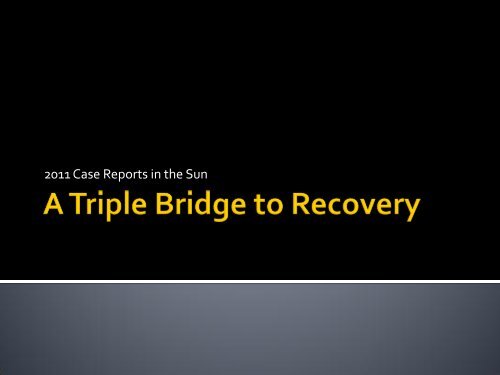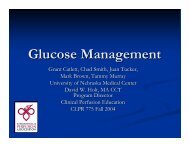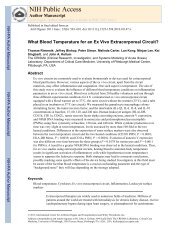PowerPoint Presentation (PDF) - Perfusion.com
PowerPoint Presentation (PDF) - Perfusion.com
PowerPoint Presentation (PDF) - Perfusion.com
You also want an ePaper? Increase the reach of your titles
YUMPU automatically turns print PDFs into web optimized ePapers that Google loves.
2011 Case Reports in the Sun
2011 Case Reports in the Sun<br />
Relevant Disclosures:<br />
• Will discuss off-label application and use of medical devices<br />
• Have served as a paid consultant for Thoratec Corporation<br />
• Have served as a paid consultant for SynCardia Systems
Implant Profile<br />
CPS/ ECMO<br />
22%<br />
Centrimag VAS<br />
21%<br />
AbioMed Impella<br />
4%<br />
AbioMed BVS<br />
2%<br />
Thoratec VAD<br />
9%<br />
AbioMed AB<br />
4%<br />
HeartWare LVAS<br />
3%<br />
DuraHeart LVAS<br />
1%<br />
CardioWest TAH<br />
10%<br />
HeartMate II<br />
22%<br />
HeartMate XVE<br />
2%
Indication Profile<br />
BT 2nd MCSD<br />
21%<br />
BTT<br />
24%<br />
DT<br />
24%<br />
BTR<br />
31%
44 y/o Native American woman with a 104-day bridge to recovery with<br />
3 mechanical circulatory assist devices<br />
13 days<br />
Fulminant Myocarditis with Cardiogenic<br />
Shock, Circulatory Collapse, CPR & ECMO<br />
33 days<br />
CentriMag BiVAD<br />
RVAD<br />
oxygenator<br />
58 days<br />
PVAD BiVAD<br />
Myocardial Recovery<br />
& Device Explant
Case Report<br />
Vital Signs<br />
HR: 150’s<br />
BP: 62/34<br />
SaO2: 65%<br />
Labs<br />
Echo<br />
BNP: > 3000<br />
EF: 10%<br />
Inotropes<br />
Dobutamine: 5<br />
Milrinone: 0.5<br />
Norepi: 40<br />
Exam<br />
cold distal extremities<br />
pulses not palpable<br />
poor capillary refill<br />
pupils equal and reactive<br />
• 44 y/o Native American woman<br />
• Approx 1-week upper resp infection w/ nausea<br />
• Progressively worsening flu-like symptoms<br />
• Daughter finds her passed out at home<br />
• Emergently transported to nearby county hospital –<br />
further deterioration, intubated<br />
• Transferred to Mayo Clinic 24 hrs later<br />
• History<br />
• NKA, no previous surgeries<br />
• 8 children<br />
• Morbid obesity<br />
• Social alcohol only, never smoked<br />
• No other illnesses, no outside medications
Case Report<br />
Assessment<br />
severe cardiogenic shock<br />
Intra-aortic Balloon Pump<br />
source unknown – likely viral<br />
circulatory collapse<br />
cardiorespiratory arrest<br />
active CPR<br />
Plan<br />
urgent initiation of ECMO<br />
circulatory & pulmonary<br />
stabilization<br />
evaluation for<br />
transplantation<br />
ECMO Circuitry<br />
CentriMag pump<br />
Quadrox-d oxygenator<br />
Terumo x-coated tubing<br />
Cannulation<br />
17 Fr right femoral artery<br />
20 Fr right femoral vein<br />
• ECMO Insertion in ICU<br />
• Cardiorespiratory arrest at start of procedure<br />
• Difficulty locating left femoral artery & vein under<br />
direct dissection<br />
• IABP already in right femoral artery – removed over a<br />
wire and site used for femoral arterial cannula<br />
• Venous access line already in right femoral vein –<br />
removed over a wire and site used for femoral venous<br />
cannula<br />
• Heparin 10,000U given. ACT > 200 seconds.<br />
• Right lower leg ischemia on POD 1.<br />
• 8 Fr cannula inserted into Superficial Femoral Artery<br />
• Connected by ¼ inch tubing and luer connector to<br />
ECMO arterial line
Case Report<br />
Assessment<br />
severe cardiogenic shock<br />
Intra-aortic Balloon Pump<br />
source unknown – likely viral<br />
circulatory collapse<br />
cardiorespiratory arrest<br />
active CPR<br />
Plan<br />
urgent initiation of ECMO<br />
circulatory & pulmonary<br />
stabilization<br />
evaluation for<br />
transplantation<br />
ECMO Circuitry<br />
CentriMag pump<br />
Quadrox-d oxygenator<br />
Terumo x-coated tubing<br />
Cannulation<br />
17 Fr right femoral artery<br />
20 Fr right femoral vein
Case Report<br />
Assessment<br />
severe cardiogenic shock<br />
Intra-aortic Balloon Pump<br />
source unknown – likely viral<br />
circulatory collapse<br />
cardiorespiratory arrest<br />
active CPR<br />
Plan<br />
urgent initiation of ECMO<br />
circulatory & pulmonary<br />
stabilization<br />
evaluation for<br />
transplantation<br />
ECMO Circuitry<br />
CentriMag pump<br />
Quadrox-d oxygenator<br />
Terumo x-coated tubing<br />
Cannulation<br />
17 Fr right femoral artery<br />
20 Fr right femoral vein
Case Report<br />
Thoratec PVAD Cannulas<br />
Right Atrium – short, beveled tip<br />
with side holes<br />
C/N 10075-2574-001<br />
44 Fr tip<br />
25 cm length<br />
Left Ventricle – long, straight,<br />
beveled tip with side holes<br />
C/N 14111-2571-000<br />
48 Fr tip<br />
25 cm length<br />
Aorta & Pulmonary Artery – long,<br />
straight with sealed graft<br />
C/N 100129<br />
18 mm graft<br />
30 cm length<br />
GISH Connectors<br />
5/8” x 3/8” Reducing Connector<br />
C/N EC2150S<br />
• Patient stabilized over several days on ECMO<br />
• Ongoing renal & hepatic dysfunction<br />
• Ongoing pulmonary edema<br />
• TEE evaluation<br />
• Distended, hypocontractile heart<br />
• No signs of cardiac recovery<br />
• ECMO exchanged for CentriMag BiVAD in OR<br />
• Central Cannulation performed on bypass<br />
▪<br />
140 minutes on CPB<br />
• Using tunneled PVAD cannulas<br />
• RA to PA<br />
• LV to Aorta<br />
• Pulmonary failure weaning from CPB<br />
• Oxygenator in RVAD circuit
Case Report<br />
Thoratec PVAD Cannulas<br />
Right Atrium – short, beveled tip<br />
with side holes<br />
C/N 10075-2574-001<br />
44 Fr tip<br />
25 cm length<br />
Left Ventricle – long, straight,<br />
beveled tip with side holes<br />
C/N 14111-2571-000<br />
48 Fr tip<br />
25 cm length<br />
Aorta & Pulmonary Artery – long,<br />
straight with sealed graft<br />
C/N 100129<br />
18 mm graft<br />
30 cm length<br />
Connectors<br />
5/8” x 3/8” (qty 4)<br />
Tubing<br />
4’ x 3/8” (qty 4)
Case Report<br />
Tubing markings<br />
Colors<br />
Blue colors mark RVAD<br />
Red colors mark LVAD<br />
Single Lines<br />
Signifies directional blood<br />
flow from patient into pump<br />
Double Lines<br />
Signifies directional blood<br />
flow from pump into patient<br />
Proper Nomenclature<br />
Inlet and Outlet confusing<br />
Patient centric<br />
Pump centric<br />
Best Practice<br />
Inlet & Outlet are “forbidden” terms<br />
Name lines for the<br />
anatomical structure to<br />
which they connect (i.e. right<br />
atrium, left ventricle, aorta)
Case Report<br />
Tubing markings<br />
Colors<br />
Blue colors mark RVAD<br />
Red colors mark LVAD<br />
Single Lines<br />
Signifies directional blood<br />
flow from patient into pump<br />
Double Lines<br />
Signifies directional blood<br />
flow from pump into patient<br />
Proper Nomenclature<br />
Inlet and Outlet confusing<br />
Patient centric<br />
Pump centric<br />
Best Practice<br />
Inlet & Outlet are “forbidden” terms<br />
Name lines for the<br />
anatomical structure to<br />
which they connect (i.e. right<br />
atrium, left ventricle, aorta)
Case Report<br />
“Blue Bands”<br />
Simple latex-free, 1-cm polyisoprene<br />
strips of blue band identifiers<br />
Bioseal – Placentia, CA<br />
Used to help prevent extensive<br />
formation of adhesions and<br />
minimize difficulty in dissecting<br />
major vascular structures during<br />
device explant for HTX or recovery<br />
Benefits:<br />
Inexpensive<br />
Easily sterilized<br />
Facilitates identification<br />
Reduced dissection time<br />
Bands are cut to 9 cm length before<br />
gas sterilization<br />
Loosely encircled around IVC, SVC,<br />
PA & Ao and ends clipped together<br />
Ann Thorac Surg 2009; 87: 1623-4.
Case Report<br />
CentriMag BiVAD Pump Exchange<br />
Prime & de-bubble two new CMag<br />
pump sets with tubing<br />
Label LVAD & RVAD inlet and<br />
outlet with proper tapes<br />
Clamp all 4 cannula sites above and<br />
below the 5/8” x 3/8” connectors<br />
Disconnect lines on 3/8” end<br />
Briefly bleed each connector<br />
to clean loose fibrin deposits<br />
Make sterile wet-to-wet connections<br />
between cannulas and new pumps<br />
Set & secure new pumps in<br />
proper LVAD/RVAD motors<br />
Verify proper connections according<br />
to red/blue and single/double tapes<br />
Turn on pumps & release all clamps<br />
Return to previous pump<br />
speed & flow alarm settings<br />
• RVAD oxygenator removed s/p BiVAD CMag day 7<br />
• Pumps exchanged s/p BiVAD CMag day 12<br />
• Loose fibrin stranding found at 3/8” tubing<br />
connection of both LVAD and RVAD pump outlets<br />
• No fibrin depositions found at 5/8” x 3/8” connectors<br />
• Successful chest closure s/p BiVAD CMag day 18<br />
• 9 mediastinal explorations for control of bleeding<br />
• 6 in ICU, 3 in OR<br />
• Awake, alert & extubated s/p BiVAD CMag day 22<br />
• Patient participated in bed-side rehabilitation<br />
including standing but was too weak for walking<br />
• TEE evaluation s/p BiVAD CMag day 30<br />
• Distended, hypocontractile heart<br />
• Slight signs of cardiac recovery<br />
• PVAD exchange in OR s/p BiVAD CMag day 33
Switch Procedure<br />
The patient has had an opportunity to wake, be evaluated for cardiac recovery or<br />
transplant, and hopefully has begun recovering end-organ function,<br />
rehabilitating and returning to an anabolic state.<br />
Additionally, the patient’s chest has likely been closed since being place on<br />
CentriMag support.<br />
Switching to PVAD for long-term support is a non-invasive procedure but still<br />
with risk and should be conducted in the OR with the full cardiac surgery team.<br />
CPB stand-by is highly re<strong>com</strong>mended.
Switch Procedure<br />
Participants in the procedure should all be VAD-trained members of the<br />
cardiac surgery team:<br />
• CT Surgeon<br />
• 1 st Assistant<br />
• Surgical Scrub<br />
• Cardiac Anesthesia<br />
• Cardiology or other TEE operator<br />
• VAD Operator<br />
• <strong>Perfusion</strong>ist on CPB stand-by<br />
• Circulating Nurses
CentriMag to PVAD<br />
switch procedure<br />
Second Procedural Pause<br />
Identify the players and their<br />
roles. All others in the room<br />
will be silent during the switch.<br />
Talk out every step and assign<br />
who will be doing what.<br />
Confirm LVAD & RVAD<br />
cannulas. Mark the direction of<br />
blood flow.<br />
Verify PVAD pump orientation.<br />
Will the LVAD be right-side up<br />
or up-side down? RVAD?<br />
Note the current CentriMag<br />
blood flow. This will be the<br />
target PVAD blood flow.<br />
• Preparation<br />
• Prep & drape the patient for median sternotomy and<br />
possible groin access<br />
• Using TEE, evaluate cardiac function & look for<br />
ventricular & valvular clots<br />
• Hang and connect inotropes & pressors (Epinephrine,<br />
Dobutamine, Milrinone, Norepi, Vasopressin) and<br />
have blood products in the room checked for use<br />
• Conduct your standard time-out<br />
• Set up the DDC, prime the PVADs, and connect the<br />
pneumatic & electrical leads to the pump & console<br />
• Start sufficient inotropic support so patient can selfsustain<br />
for up to 5-10 minutes<br />
• Give ½ CPB table dose heparin bolus<br />
• Conduct 2 nd procedural pause while waiting for ACT
CentriMag to PVAD<br />
switch procedure<br />
Important Points<br />
Verify correct direction of<br />
blood flow before AND after<br />
connecting pump to cannulas<br />
Thoratec Cannula Connection<br />
Tool can speed the process but<br />
requires prior practice using<br />
Briefly rotate and turn pump to<br />
look for signs of gross air within<br />
pump chamber, on valves or<br />
inside cannulas and repeat deairing<br />
procedure if necessary<br />
Slide metal collet and white nut<br />
down cannula onto pump and<br />
hand-tighten only<br />
• Clamp and Go!<br />
1. Patient in Trendelenburg position<br />
2. Place a tubing clamp on each PVAD cannula as close<br />
to the velour as possible w/o bending the wire<br />
reinforcements (4 clamps used)<br />
3. Place a tubing clamp on each CMag line near the<br />
5/8”x3/8” connectors (4 add’l clamps used)<br />
4. CMag consoles OFF<br />
5. Trim PVAD cannulas as close to 5/8” connectors as<br />
possible to leave room for connecting to PVAD<br />
pump<br />
6. Scrub pulls away CMag lines while Surgeon &<br />
Assistant slide white nut & metal collet on cannulas<br />
7. Scrub brings LVAD PVAD pump to field for surgeon<br />
to slip into LVAD cannulas while Assistant fills gaps<br />
with saline for a bubble-free wet-to-wet connection
CentriMag to PVAD<br />
switch procedure<br />
Important Points<br />
Verify correct direction of<br />
blood flow before AND after<br />
connecting pump to cannulas<br />
Thoratec Cannula Connection<br />
Tool can speed the process but<br />
requires prior practice using<br />
Briefly rotate and turn pump to<br />
look for signs of gross air within<br />
pump chamber, on valves or<br />
inside cannulas and repeat deairing<br />
procedure if necessary<br />
Slide metal collet and white nut<br />
down cannula onto pump and<br />
hand-tighten only
CentriMag to PVAD<br />
switch procedure<br />
Important Points<br />
Verify correct direction of<br />
blood flow before AND after<br />
connecting pump to cannulas<br />
Thoratec Cannula Connection<br />
Tool can speed the process but<br />
requires prior practice using<br />
Briefly rotate and turn pump to<br />
look for signs of gross air within<br />
pump chamber, on valves or<br />
inside cannulas and repeat deairing<br />
procedure if necessary<br />
Slide metal collet and white nut<br />
down cannula onto pump and<br />
hand-tighten only<br />
• Consider starting LVAD if patient is unstable<br />
8. Scrub brings RVAD PVAD pump to field for surgeon<br />
to slip into RVAD cannulas while Assistant fills gaps<br />
with saline for a bubble-free wet-to-wet connection<br />
9. Release all remaining tubing clamps<br />
10. Start both LVAD & RVAD at rate of 40 b/min while<br />
monitoring for signs of air with TEE<br />
11. Increase fixed rate to minimum level and switch DDC<br />
to Volume Mode when full-fill signals are consistent<br />
12. Use DDC Vacuum adjustment and blood product<br />
infusions to help achieve baseline CMag blood flows<br />
13. Begin weaning inotropic support as tolerated<br />
14. Reverse heparin<br />
• Patient may require higher CVP with PVAD than<br />
baseline with CMag due to mechanics of PF vs. CF
Case Report
Case Report<br />
Not a Good Candidate for<br />
Heart Transplantation<br />
Morbid obesity<br />
(BMI > 40)<br />
High Antibody Sensitivity<br />
(PRA > 85%)<br />
Psych/Social & family support<br />
concerns<br />
BTR Deemed Best Option<br />
LVEF 65% by TEE exams both 1<br />
week & 2 days before device<br />
removal<br />
• Patient out of bed and participating in rehab<br />
sessions twice daily s/p BiVAD PVAD day 3<br />
• Patient moved from ICU to telemetry ward s/p<br />
BiVAD PVAD day 10<br />
• Ongoing rehabilitation with functional improvement<br />
• Serial echocardiography over next month<br />
• Gradual recovery of Left Ventricle<br />
• Trailing recovery of Right Ventricle<br />
• Initiated a methodical and slow wean of VAD<br />
support s/p BiVAD PVAD day 40<br />
• Taken to OR s/p BiVAD PVAD day 58<br />
• Redo sternotomy<br />
• Removal of BiVAD on CPB (pump time 67 min)<br />
• Closure of left ventriculotomy<br />
• Removal of right atrial / left ventricular thrombus
Case Report<br />
BiVAD PVAD Weaning Process<br />
Confirm native heart tolerance of all<br />
adjustments with echo exam<br />
Always ensure LV flow > RV flow<br />
• Alternative weaning method<br />
Beginning with patient on full<br />
support in volume (auto) mode<br />
Reduce L & R vacuum<br />
settings in 20% increments<br />
When vacuum at Zero, switch to<br />
async (fixed) mode at same rate<br />
Return vacuum to ensure<br />
adequate blood pump filling<br />
Reduce L & R fixed rate<br />
settings in 20% increments<br />
At fixed rate 40 b/min (~2.6 l/min)<br />
Place a continuous flow right<br />
heart catheter in patient<br />
Quick temporary trials of<br />
VADs off under echo exam<br />
Ann Thorac Surg 2001; 71: 215–8.
Case Report<br />
Discharge Medications<br />
Atrovent inhaler<br />
Furosemide (2x day)<br />
Prilosec (daily)<br />
Spironolactone (daily)<br />
K-Dur (2x day)<br />
Norco<br />
Zestril (daily)<br />
Coreg (2x day)<br />
Aspirin (daily)<br />
Loratadine (daily)<br />
PRN<br />
40 mg<br />
20 mg<br />
25 mg<br />
20 mEq<br />
PRN<br />
5 mg<br />
3.125 mg<br />
81 mg<br />
10 mg<br />
• Patient weaned from CPB with no <strong>com</strong>plications<br />
on low dose dobutamine & milrinone<br />
• Extubated s/p BiVAD explant day 1<br />
• Patient moved from ICU to telemetry ward s/p<br />
BiVAD explant day 3<br />
• Dobutamine & milrinone weaned s/p BiVAD<br />
explant day 6<br />
• Echo exam s/p BiVAD explant day 7<br />
• LVEF 40-50%<br />
• Mild tricuspid valve regurgitation<br />
• Patient discharged home s/p BiVAD explant day 11<br />
• Total Days on Device = 104<br />
• Total Days in Hospital = 115
There are cheaper and quicker ways to provide circulatory support for<br />
patients in cardiogenic shock.<br />
Why use this technique? What are the benefits?<br />
• Can extubate and rehabilitate<br />
• Chest is closed and the cannulas are secure at the heart, vessels, and<br />
skin exit sites = safe for ambulation<br />
• Tissue growth into the velour means less bleeding & infection<br />
• Still have options<br />
• Setup for PVAD if longer BTR or if BTT is required<br />
▪ Is he/she a HTX candidate? Is the disease process recoverable?<br />
• Setup for ECMO if pulmonary failure occurs or returns<br />
▪ Splice oxygenator into RVAD pump outlet line<br />
J Heart Lung Transplant 2009; 28: 984-986. Interact CardioVasc Thorac Surg 2011; 12: 110-111.
There are cheaper and quicker ways to provide circulatory support for<br />
patients in cardiogenic shock.<br />
Why use this technique? What are the benefits?<br />
• Cheaper than alternative systems<br />
• AB5000 not BTT or discharge approved<br />
▪ Complete pump & cannula change required for BTT<br />
• Direct to PVAD more costly if patient does not survive<br />
▪ PVAD > $100,000 vs. CMag < $40,000<br />
• Physiologic Advantages<br />
• Reduced shear stress on blood = lower hemolysis<br />
• No diastolic “filling” time = no stagnant blood = lower thrombosis<br />
• 30-day survival up to 75% w/ CMag used in acute cardiogenic shock<br />
J Thorac Cardiovasc Surg 2011; 141: 932-9. J Thorac Cardiovasc Surg. 2007; 134: 351-8.
Physiologic<br />
Advantages of CF<br />
pumps vs. PF pumps<br />
Patients presenting in<br />
circulatory failure will share<br />
some <strong>com</strong>mon characteristics.<br />
The result is patients quickly<br />
deteriorate into Multi-System<br />
Organ Failure (MSOF).<br />
An increase in CVP with a<br />
decrease in MAP results in a<br />
lower trans-organ perfusion<br />
pressure and the tissues<br />
be<strong>com</strong>e congested from an<br />
absence of venous<br />
de<strong>com</strong>pression.<br />
Decreased CO<br />
Lower MAP<br />
Higher PCWP<br />
Higher CVP<br />
Reduced tissue perfusion<br />
The organs begin to fail<br />
without adequate blood flow.<br />
End-organ dysfunction
Outflow (L/min)<br />
Outflow (L/min)<br />
CONTINUOUS FLOW PUMP<br />
PULSATILE FLOW PUMP<br />
30<br />
25<br />
20<br />
15<br />
Pump speed = 10,000 RPM<br />
30<br />
25<br />
20<br />
15<br />
10<br />
5<br />
0<br />
-5<br />
-10<br />
10<br />
5<br />
0<br />
-5<br />
-10<br />
Flow Waveforms for Continuous Flow and Pulsatile Flow Pumps<br />
(Both have average flow between 4-5 L/min)
CONTINUOUS FLOW PUMP<br />
• Lower CVP & PCWP<br />
• Pump inlet always diastolic<br />
• Pump outlet always<br />
systolic<br />
• Example:<br />
• Pump Flow 5.5 l/min<br />
• MAP 80<br />
• CVP 8<br />
• <strong>Perfusion</strong> Pressure 72<br />
PULSATILE FLOW PUMP<br />
• Higher CVP & PCWP<br />
• Shorter diastolic time to<br />
maintain higher rate for<br />
adequate blood flow<br />
• Example:<br />
• Pump Flow 5.5 l/min<br />
• MAP 70<br />
• CVP 20<br />
• <strong>Perfusion</strong> Pressure 50
J Heart Lung Transplant 2011; 30: 862–9.
Physiologic<br />
Advantages of CF<br />
pumps vs. PF pumps<br />
Application of intermediate CF<br />
BiVAD support to improve<br />
long-term PF BiVAD out<strong>com</strong>e<br />
Patients can be diuresed to low<br />
RA & LA filling pressures w/o<br />
adverse drop in pump flow<br />
Improved trans-organ tissue<br />
perfusion pressures by venous<br />
de<strong>com</strong>pression<br />
Promotes pulmonary, renal,<br />
hepatic decongestion and<br />
recovery<br />
Higher<br />
MAP<br />
Lower<br />
PCWP<br />
Lower<br />
CVP<br />
Improved<br />
tissue<br />
perfusion<br />
Patients in circulatory shock &<br />
MSOF can be optimized for<br />
pulsatile BiVAD support<br />
Increased<br />
CO
Cardiogenic<br />
Shock<br />
On ECMO<br />
Recovery<br />
possible?<br />
No recovery<br />
possible?<br />
CentriMag w/<br />
PVAD cannulas<br />
Transplant<br />
Evaluation<br />
Recovery<br />
within weeks?<br />
Recovery over<br />
a few months?<br />
Yes.<br />
No.<br />
Continue<br />
CentriMag<br />
Consider<br />
switch to PVAD<br />
Implant BTT<br />
approved<br />
device<br />
Consider DT<br />
device or<br />
hospice
















